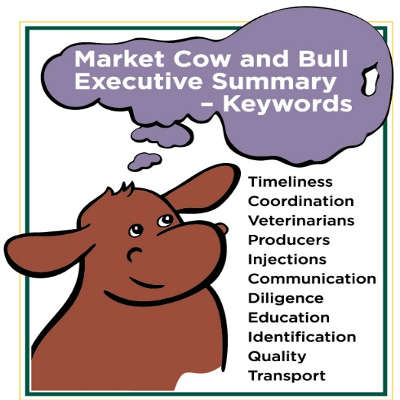By Kris Ringwall

Preparing market cows and bulls is a timeless function of beef operations.
Individual producer goals determine how many cows will remain in the herd and how many will shift to the market column. The resulting two numbers - market cow rate and replacement rate - impact the base cow herd. Managers match cattle numbers to given resources. The numbers are the foundation to expanding and/or contracting herd numbers.
Let’s take a closer look at these two numbers, but keep in mind that “market cow rate” is a better term for culling rate. Saying it is awkward at first, but keep trying, and repeat after me: market cow rate, not cull rate.
Individual herd market cow rates and subsequent replacement rates are important. North Dakota State University Extension, through the North Dakota Beef Cattle Improvement Association, keeps track of many traits for producers through the CHAPS (Cow Herd Appraisal Performance Software) program, including market cow and replacement rates.
The current benchmarks for market cow and replacement rates are 13.2 and 14.9 percent, respectively. Since 2000, the greatest yearly market cow rate was 16.7 percent; the lowest was 9.7 percent. The greatest yearly replacement rate was 17.1 percent; the lowest was 13.1 percent.
So cattle herd inventories vary by adding or subtracting cows. These inventory numbers rise and fall through good markets, poor markets, good feed, poor feed and events that impact herd management.
If the two rates are about the same, the cow herd is stable. If the market cow rate is greater than the replacement rate, the cow herd is reducing inventory. If the cow herd is increasing in cow numbers, the replacement rate should be more than the market cow rate.
This is not much different than driving on a four-lane road, a two-lane road or a gravel road. The expectations of the cow herd are a constant balance of situations, resources and time. When everything lines up, just like driving the four-lane road, accomplishments are achieved. Some years, gravel is good, and the course is slowed down a bit.
Either way, every year, cattle producers need to market older and unsound cattle. In preparation for that shift, as well as management during the marketing process, beef producers need to recap the year’s production and review their marketing strategies. An excellent document to review and ponder is a publication titled “2016 National Beef Quality Audit - Market Cow and Bull Executive Summary,” published by the Cattlemen’s Beef Board and National Cattlemen’s Beef Association.
Six areas of focus were listed:
- Food safety, as it has become the most important factor to those who purchase beef
- Appropriate management of cull cows and bulls to increase muscle condition before harvest
- Marketing animals before physical defects are too severe and cause animal welfare concerns or carcass condemnations
- Seeking to better understand causes of liver abscesses, the leading reason for liver condemnation
- Implementing measures to eliminate carcass bruising on the farm, in transport and at the harvest facility
- Reducing defects as quantified in “lost opportunities” to allow the cow and bull industry to capture additional value
As a reminder, the 2007 report had different conclusions, but they still are important. Those conclusions were:
- Reduce the use of electric prods and other aggressive driving aids when moving cattle.
- Improve footing so cattle don’t slip and injure themselves.
- Follow the guidelines for animal care and handling.
- Market your cattle before they become too thin or too lame for transport.
- Maintain record-keeping systems to verify your “best” management practices and reduce or eliminate potential for liability surrounding issues of food safety.
- Recognize and optimize the value of your market cows and bulls. Cows and bulls comprise a significant portion of your farm or ranch income - so they need to be managed and marketed in ways that add value - not subtract from it.
- Ensure the safety of your product. Cows and bulls must be free of chemical, pathogenic and physical hazards when you ship them for harvest.
- Continuously monitor herd health. It’s in your best interest to observe the health of your cow herd, and to ensure your market cows and bulls are marketed in a timely and appropriate manner.
- Prevent quality defects. Things like bruise, injection-site lesions, improperly placed brands, dark cutters, or cattle that too thin or too fat, have inadequate muscling caused by emaciation - are preventable.
The cattle business exists to produce beef and other byproducts for human consumption. The value of beef ultimately determines the long-term stability of the operation. As cattle producers, a primary goal needs to be to increase the value of market bulls and cows.
Source: ndsu.edu